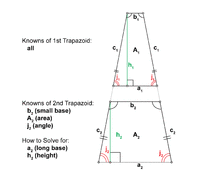I'm attempting to do a math problem, and I'm been going in circles with how to solve it 2 days. And help with the equations would be much appreciated!
I have an isosceles trapezoid, and know all of its dimensions. I would like to create another isosceles trapezoid with the same Area and angles as the first one, but with a different value for the small base.
How do I create an equation to solve this? From the equations I've found online, I need more known information to do this, but my intuition has me thinking its solvable. I've attempted to break it down into the triangles and squares, to use the slope, but my mind is moosh and could use some help. I've included a graphic I made, and some of my thinking below that runs me in circles.
My current logic, which doesnt work and I dont know why:
Variables:
A=area
b=small base
h=height
j= small angle
g=size of triangle base(not shown)
Breaking it up into 2 squares
A = b*h + h*g
g= h*tan(j) //Getting the small size from the height and angle
A = b*h + (h*(h*tan(j))) //equations combined
But everything after that gets weird.
I have an isosceles trapezoid, and know all of its dimensions. I would like to create another isosceles trapezoid with the same Area and angles as the first one, but with a different value for the small base.
How do I create an equation to solve this? From the equations I've found online, I need more known information to do this, but my intuition has me thinking its solvable. I've attempted to break it down into the triangles and squares, to use the slope, but my mind is moosh and could use some help. I've included a graphic I made, and some of my thinking below that runs me in circles.
My current logic, which doesnt work and I dont know why:
Variables:
A=area
b=small base
h=height
j= small angle
g=size of triangle base(not shown)
Breaking it up into 2 squares
A = b*h + h*g
g= h*tan(j) //Getting the small size from the height and angle
A = b*h + (h*(h*tan(j))) //equations combined
But everything after that gets weird.

